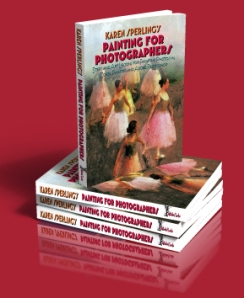Posts Tagged ‘digital imaging technique and how-to’
Book Review: Karen Sperling’s Painting for Photographers

Karen Sperling's Painting for Photographers. Cover painting and design by Karen Sperling from a photo by Felicia Tausig.
Karen Sperling’s Painting for Photographers; Steps and Art Lessons for Painting Photos in Corel Painter and Adobe Photoshop, (ISBN: 978-0-9818163-0-2) is being released by Artistry Books in multiple formats, including an autographed hardcover edition, complete with a CD of source photos to use with the tutorials, bonus tutorials and brushes, and a 10% donation to charity for $149.95; print on demand softcover edition with downloadable source photos for $85.95; regular softcover edition with downloadable source photos for $39.95; and an e-book with source photos accessible from within the digital edition for $35.95. The author is the founder of Artistry Tips and Tricks, a website that educates photographers by providing tips and techniques for creating painterly images from digital photographs. She was also the author of the first manuals on Corel Painter and has penned several other Painter books as well.
Sperling uses numerous examples to illustrate the techniques including many by other photographers as before images, with her painted version as the finished images. The inclusion of the before and after images is extremely helpful, so the reader can see and fully understand the techniques that are being explained.
Sperling offers a wide range of tips and tricks, for portraits (including people and pets) and landscapes, in addition to more general techniques. This is an important focus as many professional photographers will likely be turning portraits taken of clients into paintings. For the fine-art photographer, landscapes are an important subject to tackle, and techniques for these images are also discussed in detail.
The author begins the volume with a quote by Andrew Carnegie, “If you think you can do something, you probably can.” Sperling explains that painting is 90% thought and 10% execution.
The book offers an introduction to art concepts, which is important for the photographer who may not have taken art classes in the course of their schooling; something that really is necessary to know to turn a photograph into a painting without having it look like you just ran it through a filter or plug-in in Photoshop. Such art concepts include understanding color harmony and tonal ranges.
Sperling also explains how to turn a photo into a painting. She discusses what types of images make great starting points, how to choose an image to take further; and how you can take the best parts of an image or images, while leaving out distracting elements—turning ordinary images into extraordinary pieces of art.
An entire chapter is spent on portraits, detailing body parts and how the different types of painting, acrylic, oils, watercolor, airbrush, etc. vary the look of an image. Another really helpful part of the book is the inclusion of examples from some of the portrait-painting masters, such as Degas, Rembrandt, and others.
Sperling follows a similar tone with the Landscape chapter, showing examples of how different styles of painting can alter the look of an image.
The chapter on pets is segmented into sections focusing on cats, dogs, and horses—which is helpful, as these are the more common animals that photographers will likely be working with.
The author explains the various tools that Corel’s Painter program offers users. She also explains the powerful tools that Photoshop offers the digital imager who wants to use that program. Sperling also includes shortcuts, including explaining the benefits of utilizing a Wacom pen and tablet in turning a photo into a painting because of the added control offered by the device.
Sperling completes the book with a discussion of over-painting techniques and the supplies needed to do so. Over-painting is the technique of painting with acrylic or oil paints on top of the canvas that the image has been printed upon. It is becoming a popular technique and adds an extra quality of uniqueness to images that receive this treatment.
Sperling notes that she finds painting both on the computer and with traditional paint to be more about confidence and suggests that if the reader practices and familiarizes themselves with the materials and techniques used, they’ll be more comfortable in working with these varied media. Sperling closes by bringing the reader back to her opening sentiment that, “If you think you can, you probably can.”
Creating painterly art from photographs is ideal for the professional photographer, who can use this to add a new dimension to their studio’s offerings. The guidance and education in Karen Sperling’s Painting for Photographers takes the intimidation out of turning photographs into painted masterpieces.
Check out Karen Sperling’s website at www.karensperling.com to see examples of her work. Go to www.artistrymag.com for Sperling’s Painter tutorial site.
— Diane Berkenfeld